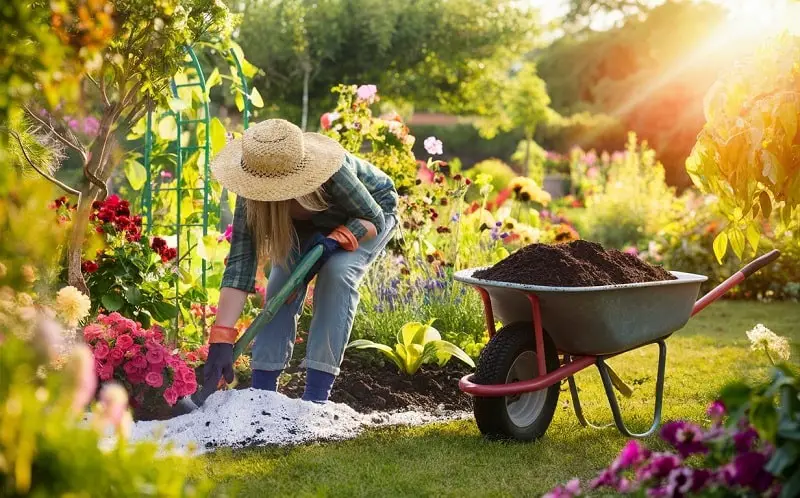Gardening is both an art and a science. While sunshine, water, and care are essential, fertilizing your garden plays a crucial role in promoting lush growth, vibrant blooms, and bountiful harvests.
Whether you’re a novice gardener or someone looking to fine-tune your green thumb, this beginner’s guide to garden fertilization will walk you through the essentials to help your garden thrive.
What is Fertilizing and Why is it Important?
At its core, fertilizing is the process of adding nutrients to your garden soil to supplement the natural minerals that plants need to grow. Over time, plants consume nutrients from the soil, depleting it of the essential elements. Fertilizing ensures that your garden continues to receive a balanced diet of nutrients, leading to healthier plants and higher yields.
Understanding the Three Major Nutrients: N-P-K
When you walk down the fertilizer aisle, you’ll likely notice three numbers on every bag, such as 10-10-10 or 5-10-5. These numbers represent the ratio of three primary nutrients:
- Nitrogen (N): Vital for leaf growth and lush, green foliage.
- Phosphorus (P): Promotes strong roots and aids in flowering and fruit production.
- Potassium (K): Enhances overall plant health, including disease resistance and drought tolerance.
Understanding the balance of these nutrients is key to choosing the right fertilizer for your garden’s specific needs.
Types of Fertilizers: Organic vs. Synthetic
One of the first decisions you’ll make is choosing between organic and synthetic fertilizers. Both have their advantages, but they work differently:
- Organic Fertilizers: Derived from natural sources like compost, manure, bone meal, and fish emulsion. Organic options release nutrients slowly and improve soil structure over time.
- Synthetic Fertilizers: Manufactured chemically, these fertilizers offer immediate nutrient availability and are often more affordable. However, they can lead to soil depletion and may require more frequent applications.
Soil Testing: The Foundation of Effective Fertilizing
Before you apply any fertilizer, it’s essential to test your soil. Soil testing provides valuable information about your soil’s pH and nutrient levels, helping you choose the correct fertilizer formulation. Many local extension offices offer soil testing services, or you can purchase a home testing kit.
A soil test will guide you on whether your garden needs more nitrogen, phosphorus, or potassium, and whether you need to adjust the pH for optimal nutrient absorption.
How and When to Fertilize Your Garden
Timing and technique are everything when it comes to effective fertilization. Here’s a quick guide on how and when to fertilize:
- Early Spring: Start the season with a balanced fertilizer to encourage growth after winter dormancy.
- Mid-Growing Season: Apply fertilizers high in nitrogen to support leafy growth.
- Pre-Blooming: Switch to a phosphorus-heavy fertilizer to enhance flowering and fruiting.
- Fall: Use a potassium-rich fertilizer to prepare plants for winter and promote root development.
When applying fertilizers, evenly spread the product around the base of the plants, taking care not to let it touch the stems directly. Water the area after fertilizing to help the nutrients penetrate the soil.
Understanding Fertilizer Labels
Reading a fertilizer label can be confusing for beginners. In addition to the N-P-K ratio, you’ll also find other terms like “slow-release,” “water-soluble,” and “granular” or “liquid” formulations. Here’s what these mean:
- Slow-Release: Fertilizers that gradually release nutrients over time, reducing the need for frequent applications.
- Water-Soluble: These fertilizers dissolve in water, allowing you to feed plants through regular watering sessions. They provide quick nutrient boosts.
- Granular vs. Liquid: Granular fertilizers are solid pellets that are spread over the soil, while liquid fertilizers are mixed with water and applied using a sprayer.
Common Fertilizing Mistakes to Avoid
Even seasoned gardeners make fertilizing errors. To get the most out of your garden, avoid these common pitfalls:
- Over-fertilizing: Applying too much fertilizer can “burn” your plants, leading to wilting and yellowing.
- Ignoring Soil pH: Even with the right nutrients, improper pH levels can block nutrient absorption.
- Fertilizing at the Wrong Time: Fertilizing too late in the season can encourage growth when plants should be focusing on hardening off for winter.
Natural Alternatives to Traditional Fertilizers
If you’re interested in a more eco-friendly approach, consider natural fertilizers. Compost, worm castings, and aged manure are excellent choices. They improve soil structure, introduce beneficial microbes, and provide a steady release of nutrients.
Compost tea is another popular choice. By steeping compost in water, you create a liquid fertilizer that is easily absorbed by plants, delivering nutrients directly to the roots.
Special Considerations for Container Gardening
Fertilizing container gardens requires a slightly different approach. Plants in containers have limited soil, meaning they exhaust nutrients faster than those in the ground. Use a slow-release fertilizer at planting and supplement with liquid feeds every few weeks.
Remember, the type of soil mix you use in containers also plays a big role. Potting mixes often come pre-fertilized, so monitor your plants for signs of nutrient deficiencies like yellowing leaves or stunted growth.
Signs Your Plants Need Fertilizing
How do you know if your plants are hungry for more nutrients? Look out for these signs:
- Yellowing Leaves: Often a sign of nitrogen deficiency.
- Poor Flowering or Fruiting: This can indicate a lack of phosphorus.
- Weak Stems and Droopy Leaves: Could signal a potassium shortage.
If you notice any of these symptoms, a targeted fertilizer application can help get your plants back on track.
Conclusion: Fertilizing for a Thriving Garden
Fertilizing might seem daunting at first, but with the right knowledge, it becomes second nature. By understanding the specific needs of your plants, choosing the right fertilizer, and applying it at the right time, you’ll set your garden up for success.
Whether you prefer organic or synthetic options, regular fertilization will keep your garden vibrant, healthy, and productive.
Happy gardening!
